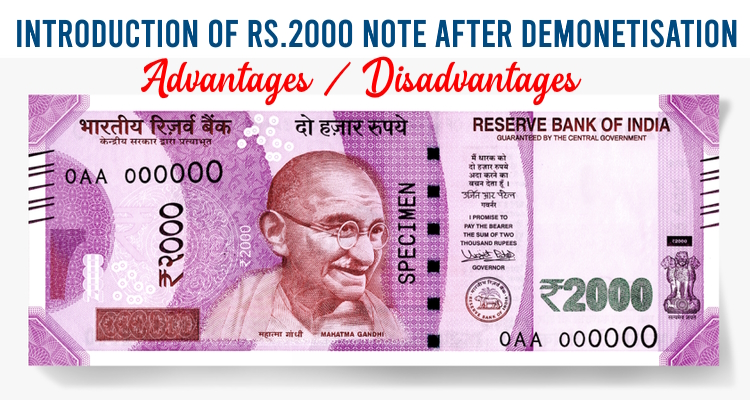Advantages and Disadvantages INR 2000 Note
In November 2016, India witnessed a significant economic event known as demonetization, which aimed to curb corruption, black money, and counterfeit currency. As part of this exercise, the Indian government introduced new currency denominations, including the Rs. 2000 note. The introduction of the Rs. 2000 note had both advantages and disadvantages, sparking debates and discussions among economists, policymakers, and citizens. In this article, we will explore the benefits and drawbacks of the introduction of the Rs. 2000 notes in the aftermath of demonetization.

Table of Contents
- 1 Advantages of Introducing Rs.2000 Notes
- 1.1 Curbing Counterfeit Currency
- 1.2 Convenience in Transactions
- 1.3 Storage Efficiency
- 1.4 Cash Flow Management
- 1.5 Tax Compliance
- 1.6 Reduction in Printing Costs
- 1.7 International Recognition
- 1.8 Cash Reserves for Emergency Situations
- 1.9 Efficient Cross-Border Transactions
- 1.10 Confidence and Psychological Impact
- 2 Disadvantages of Introducing Rs.2000 Notes
- 3 Conclusion
Advantages of Introducing Rs.2000 Notes
Curbing Counterfeit Currency
The introduction of the Rs. 2000 note was accompanied by advanced security features to prevent counterfeiting. These features included high-quality printing, color-shifting ink, and other technological measures. The enhanced security measures aimed to reduce the circulation of fake currency and protect the economy from illicit activities.
Convenience in Transactions
The higher denomination of the Rs. 2000 note provided convenience in carrying out large-value transactions. It reduced the need for individuals and businesses to carry a significant amount of cash, thus increasing safety and efficiency in financial transactions. The availability of a higher denomination note facilitated faster and more convenient transactions, especially in sectors where substantial amounts of cash are involved, such as real estate or high-value purchases.
Storage Efficiency
The introduction of the Rs. 2000 note improved storage efficiency for individuals and businesses. With fewer high-value notes, the physical storage required for large sums of money decreased, saving space and reducing logistical challenges. This efficiency benefited both households and businesses by streamlining cash management processes.
Cash Flow Management
The Rs. 2000 note facilitated better cash flow management for banks and financial institutions. With a higher denomination note, fewer physical notes were needed to meet withdrawal demands, reducing the burden on the banking system and enhancing its efficiency. It also reduced the frequency of cash replenishment, making cash management more cost-effective for banks.
Tax Compliance
The introduction of the Rs. 2000 note aimed to promote a digital economy and encourage tax compliance. The demonetization exercise, coupled with the higher denomination note, encouraged individuals and businesses to shift towards digital transactions, thereby reducing the reliance on cash transactions that are often associated with tax evasion. The digital push facilitated by the higher denomination note supported the government’s efforts to broaden the tax base and increase transparency in financial transactions.
Reduction in Printing Costs
The introduction of higher denomination notes, such as the Rs. 2000 note, can lead to a reduction in printing costs for the central bank. Since higher denomination notes have a higher value, fewer physical notes need to be printed to achieve the same monetary value. This cost-saving measure can benefit the overall economy and optimize the resources of the central bank.
International Recognition
Introducing a higher denomination note like the Rs. 2000 note can enhance India’s international recognition and standing. It signals a robust economy and the ability to handle large-value transactions, which can improve confidence among foreign investors and promote economic growth.
Cash Reserves for Emergency Situations
Higher denomination notes, such as the Rs. 2000 note, can serve as an emergency cash reserve for individuals and businesses during unforeseen circumstances. In situations where digital payment systems may be temporarily disrupted or inaccessible, having higher denomination notes can help ensure immediate access to funds for essential needs.
Efficient Cross-Border Transactions
Higher denomination notes facilitate smoother cross-border transactions. Travelers and businesses engaging in international trade can carry fewer physical notes when dealing with large sums of money. This convenience can streamline international transactions, reduce administrative burdens, and foster economic cooperation with other countries.
Confidence and Psychological Impact
The introduction of a higher denomination note like the Rs. 2000 note can instill a sense of confidence and stability among the public. It signifies the government’s commitment to addressing economic challenges, and the presence of higher-value currency notes can contribute to a positive psychological impact, fostering trust in the currency system.
Disadvantages of Introducing Rs.2000 Notes
Inconvenience for Daily Transactions
The higher denomination of the Rs. 2000 note posed challenges in daily transactions, especially for individuals and small businesses involved in low-value transactions. The scarcity of smaller denominations and the dominance of the Rs. 2000 note made it difficult to obtain change for smaller expenses, leading to inconvenience for the common public.
Encouragement of Cash Hoarding
The introduction of the Rs. 2000 note might have inadvertently encouraged cash hoarding tendencies among some individuals. The psychological allure of possessing a higher-value note could have led to a reluctance to spend or deposit the money, resulting in cash being kept out of the formal banking system.
Impact on Cashless Economy Goals
While the higher denomination note aimed to promote a digital economy, its introduction might have temporarily hampered the progress towards that goal. With a focus on the availability of cash during the demonetization period, the emphasis on digital payments might have taken a backseat. The reintroduction of a higher-value note could have led to a preference for cash transactions, thereby impeding the transition to a cashless economy.
Increased Risk of Counterfeiting
Despite the advanced security features incorporated into the Rs. 2000 note, the higher denomination attracted counterfeiters. The introduction of a new note provided an opportunity for criminals to replicate and circulate fake currency, which could have adverse effects on the economy and erode public trust in the currency system.
Cash Hoarding and Black Money
The availability of higher denomination notes can potentially facilitate cash hoarding and the circulation of black money. Individuals with illicit wealth may find it easier to conceal large sums of money in the form of Rs. 2000 notes, undermining the government’s efforts to curb corruption and promote transparency.
Vulnerability to Robbery and Theft
Carrying higher denomination notes, such as the Rs. 2000 note, can make individuals more vulnerable to robbery or theft. The conspicuous nature of these notes can attract unwanted attention and increase the risk of being targeted by criminals. This potential risk may discourage people from carrying larger denomination notes, affecting their daily financial activities.
Inequality and Disparity
The introduction of higher denomination notes can exacerbate existing income inequality and wealth disparity in society. Individuals with higher purchasing power may benefit more from the convenience and acceptance of the Rs. 2000 note, while those with lower incomes may face difficulties in accessing change or participating in cash-based transactions.
Potential for Money Laundering
The presence of higher denomination notes can increase the potential for money laundering activities. Criminals can exploit the anonymity and portability of large-value notes to facilitate illicit financial transactions, thereby undermining efforts to combat money laundering and illicit financial flows.
Conclusion
The introduction of the Rs. 2000 note after demonetization had both advantages and disadvantages. While it aimed to address various economic challenges, including counterfeiting and tax evasion, it also presented certain drawbacks. The convenience in large-value transactions, improved cash flow management, and enhanced security features were some of the advantages associated with the higher denomination note.
However, concerns related to hoarding black money, inconvenience in daily transactions, and potential setbacks in the move towards a cashless economy were some of the disadvantages. It is essential for policymakers to carefully evaluate the pros and cons of introducing higher denomination notes and strike a balance that aligns with the broader objectives of the economy and the welfare of its citizens.



